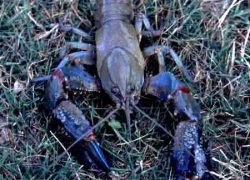![]()
Feb. 28, 2008
 Photo Caption: The mainland yabby
(Cherax destructor) commonly reaches 15 cm in length. Source: Jean Jackson,
Inland Fisheries Service
Photo Caption: The mainland yabby
(Cherax destructor) commonly reaches 15 cm in length. Source: Jean Jackson,
Inland Fisheries Service
The fighting Australian yabby does not forget
the face of its foes says new research from University of Melbourne
zoologists.
The research by the Universityfs Department of Zoology
has been published today in the PLoS ONE journal.
The two year study
involving over 100 pairs of yabbies revealed that the species Cherax destructor
is capable of facial recognition of individuals, particularly its opponents.
gThis is a remarkable capacity for the invertebrate species of yabbies
and freshwater crayfish. This is an ability known in humans and some vertebrates
but in only a handful of invertebrate species,h said Professor David MacMillan,
Head of the Department of Zoology who has led the research.
gYabbies
usually fight when they meet
It is as much a way of meeting each other as a way of establishing territory.h
Professor Macmillan said an
understanding of how simple nervous systems recognise features may assist in
developing feature recognition in robots.
In the study, after a fight,
the loser yabby was isolated and given a choice between its opponent and another
crayfish not involved in the fight.
The loser yabby moved towards the
opponent it knew as opposed to the rival it did not, revealing that a yabby is
capable of visual identity not just an acute sense of smell.
gCareful
observation by our team showed that the facial region is the important area for
recognition of yabbies during and after a fight,h Professor Macmillan
said.
gIn particular we showed highly variable cues are used such as
colour and face width.h
Researchers also tested whether it is possible to
engineer false identifications and whether animals can distinguish between twin
opponents.
gWe continue to find the yabby is capable of more than we
expected for an animal with such a simple nervous system and an
invertebrate.h
"Yabbies remember the smell of other crayfish but the
extent to which they remember visual features has previously been
unknown.h
---